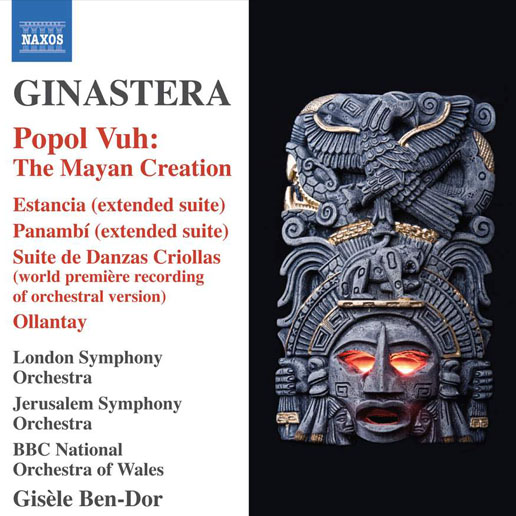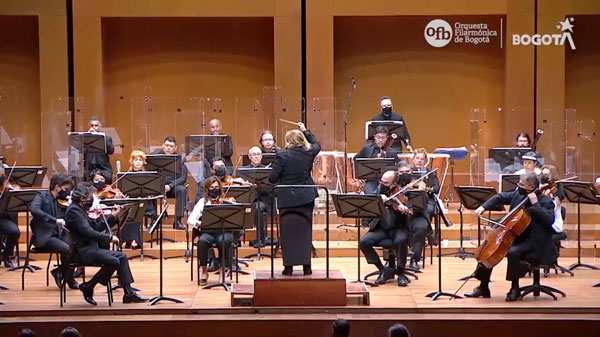World Premiere of the Opera Cuitláhuatzin, by Samuel Zyman and Samuel Maynez, Mexico City, Iztapalapa, Macroplaza, October 22nd, 2022
The opera celebrates the Aztec hero Cuitláhuac,victorious against the Spanish conquerors. Undefeated in war, he was ultimately a victim of plague brought by the Spaniards. The opera is sung in Nahuatl, the Aztec language of the Mexica. It is spoken by 1,5 million people in Mexico.
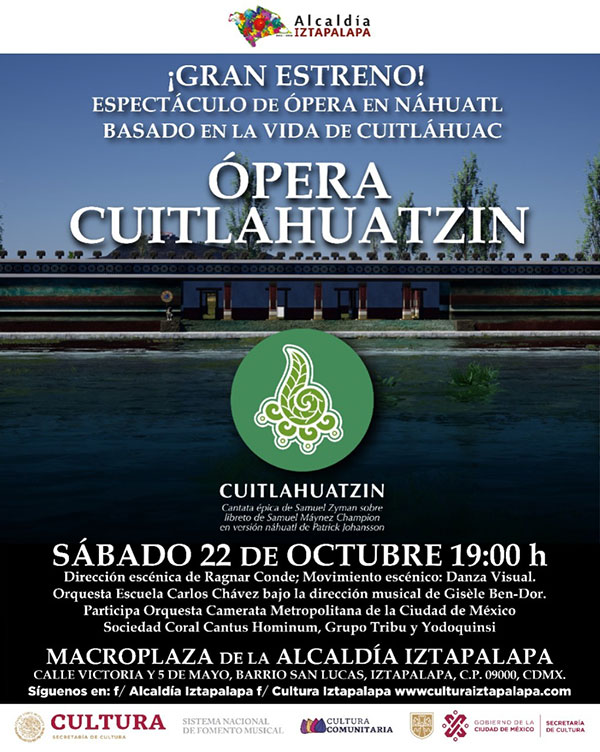
To see a Spanish language review of Cuitlahuatzin please click here.
Conductor Gisele Ben-Dor debuts in Colombia with the Orquesta Filarmónica de Bogotá
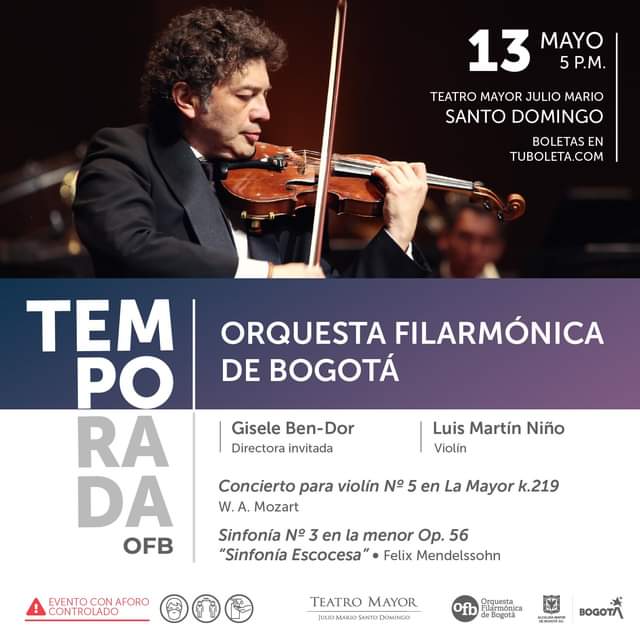
On Thursday May 13th 2021, at the TeatroMayor, in one of the first concerts since the pandemic, the American – Israeli maestra lead a program of Mozart and Mendelssohn.
To see a clip of this performance please click the image below.
Gisele Ben-Dor joins EQUINOTE in a series of programs devoted to making music and culture accessible to audiences living with disabilities.
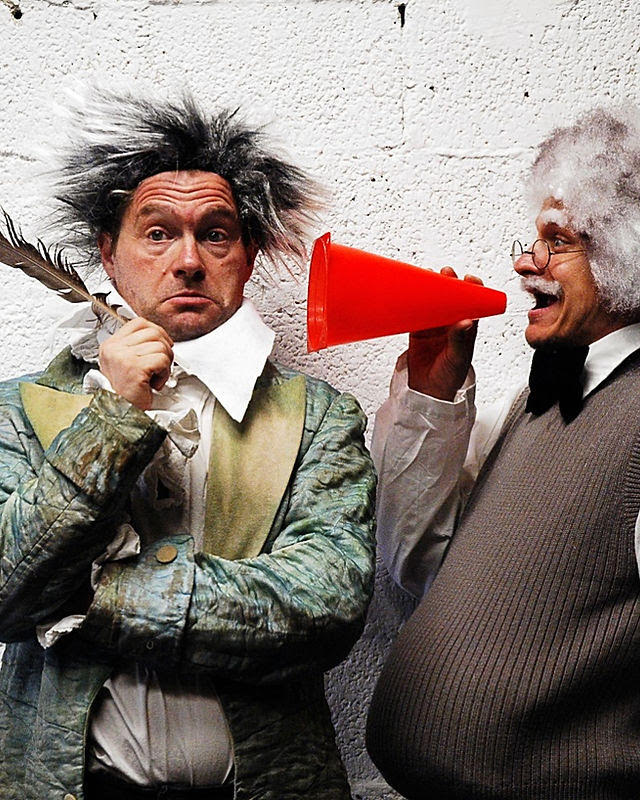 TOUCHING THE SOUNDS WITH BEETHOVEN
TOUCHING THE SOUNDS WITH BEETHOVEN
A unique program combining music, play and science – Inspired by Beethoven’s life story, who despite his deafness continued to compose masterpieces. A story about friendship, the human spirit and its ability to overcome disabilities.
ABOUT EQUINOTE
Equinote was created out of the wish to make music and culture accessible to children and adults living with physical and/or mental disabilities.
Equinote creates, supports and promotes projects with the concept of accessibility at core. Through concerts and workshops, it raises awareness on the obstacles people living with disabilities might encounter, while promoting values of acceptance of others and diversity.
Equinote develops new ways to experience music and culture in an accessible, enjoyable and inspirational way while maintaining high artistic quality and technological innovativeness.
To learn more about Equinote please click here.
Conductor wins Great American, Great Immigrant award
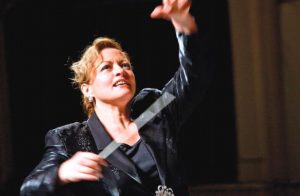
Photo by Henry Fair
Former SB Symphony conductor honored for societal contributions
Uruguay immigrant and former Santa Barbara Symphony conductor Gisèle Ben-Dor was one of 34 naturalized citizens who received the “Great Immigrant, Great American” award, which celebrates the many ways in which immigrants enrich culture, strengthen democracy and improve society through their lives, work and examples.
The Carnegie Corporation of New York, one of the nation’s oldest grantmaking foundations, recognized a former conductor of the Santa Barbara Symphony this past Fourth of July.
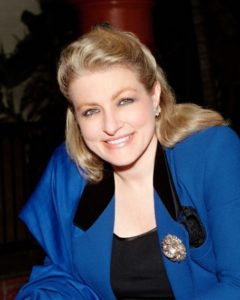 Uruguay immigrant Gisèle Ben-Dor was one of 34 naturalized citizens who received the “Great Immigrant, Great American” award, which celebrates the many ways in which immigrants enrich culture, strengthen democracy and improve society through their lives, work and examples.
Uruguay immigrant Gisèle Ben-Dor was one of 34 naturalized citizens who received the “Great Immigrant, Great American” award, which celebrates the many ways in which immigrants enrich culture, strengthen democracy and improve society through their lives, work and examples.
“Being a woman conductor may not be normal to the outside world, but it’s normal to me,” Ms. Ben-Dor told the Jewish Telegraphic Agency once. “I must say that since I came to the United States, I have been given every opportunity, and I hope I deserve it.”
Now she is the conductor of the Pro Arte Chamber Orchestra of Boston.
Ms. Ben-Dor is widely regarded as one of the world’s finest and most dedicated exponents of the Latin American repertoire, and she plays a crucial role in the rejuvenation and promotion of Latin American music. The American-Israeli conductor graduated from the Rubin Academy of Music, Tel Aviv University and the Yale School of Music, also studying with Mendi Rodan in Jerusalem.
Her most famous Latin American works include: “Ginastera,” “Villa-Lobos,” “Revueltas,” “Piazzolla” and “Luis Bacalov.”
Carnegie New York quoted Vartan Gregorian, the late president of the corporation, upon handing out the awards, saying: “Great immigrants have come from different backgrounds and have pursued different worthwhile goals, but collectively, they have shared a desire to become citizens and have made our democratic society stronger. For all of their efforts, we salute them.”
The Carnegie Corporation of New York celebrates exemplary contributions of immigrants to American life every Fourth of July. The winners have a wide variety of backgrounds and careers.
The Great Immigrants initiative reflects the priorities of Andrew Carnegie, a Scottish immigrant who rose from poverty to become a leading industrialist.
The 2021 honorees join more than 600 outstanding immigrants honored by the corporation since 2006.
Five stars: An essential disc for any lover of Ginastera’s music
Argentinian music owes a large debt to the Uruguayan-born conductor Gisèle Ben-Dor ……….her excellent conducting and the superb playing of the London Symphony created a landmark in Ginastera’s discography.
-Huntley Dent, 2022
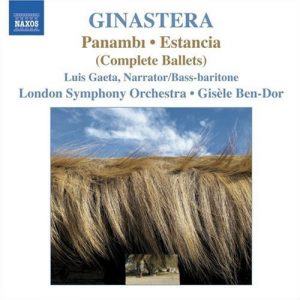 When Naxos acquired this CD in 2006 from its original label, Conifer, one of the most essential Ginastera recordings was kept in print. The purpose behind Ginastera’s two early ballets—Panambí from 1937, which he chose to make his op. 1, and Estancia from 1941—was to find a modern musical expression for deeply felt Argentinian folk roots. What the young Ginastera created is strikingly impressive. Panambí joins other scores that capture the “Indianist” spirit of indigenous peoples, such as Silvestre Revueltas’s Sensemayá and La noche de los Mayas and Carlos Chávez’s Sinfonia India. There are no real equivalents, however, for Estancia, a breakthrough score in describing the hard, isolated life of the gaucho, or Argentinian cowboy, on the vast grasslands of the Pampas.
When Naxos acquired this CD in 2006 from its original label, Conifer, one of the most essential Ginastera recordings was kept in print. The purpose behind Ginastera’s two early ballets—Panambí from 1937, which he chose to make his op. 1, and Estancia from 1941—was to find a modern musical expression for deeply felt Argentinian folk roots. What the young Ginastera created is strikingly impressive. Panambí joins other scores that capture the “Indianist” spirit of indigenous peoples, such as Silvestre Revueltas’s Sensemayá and La noche de los Mayas and Carlos Chávez’s Sinfonia India. There are no real equivalents, however, for Estancia, a breakthrough score in describing the hard, isolated life of the gaucho, or Argentinian cowboy, on the vast grasslands of the Pampas.
There was only a relatively brief period when the U.S. became aware of the richness of the folk-inspired music of Latin and South America. Aaron Copland made an extensive official tour south of the border in 1941 (presumably as part of Roosevelt’s Good Neighbor policy) and was fascinated to discover Villa-Lobos, Chávez, Ginastera, and other composers in countries that had developed their own musical culture largely outside the notice of North America. In his own words, Copland found the experience “like discovering a new continent,” yet the light of discover flickered for a while before dying out.
Argentinian music owes a large debt to the Uruguayan-born conductor Gisèle Ben-Dor and recordings like this one from 1998, in which her excellent conducting and the superb playing of the London Symphony created a landmark in Ginastera’s discography.
I’ve extended this introduction because there is such a huge distance between us and the Argentina that Ginastera lived in. It takes extensive program notes like the ones provided here to reveal the cultural significance of both ballets. But in brief, Panambí takes its title from the Panamá River in northern Argentina, the home of the Guaraní people. The ballet’s story of love and magic is derived from Guaraní legends (the score’s subtitle is “Choreographic Legend”), and its musical idiom joins the stream of primitive Modern music whose source is Le sacre du printemps. As rare as it is to hear the suite of dances that Ginastera extracted from the full score, a staging of Panambí is never likely to be encountered outside Argentina.
In 17 dances and scenes lasting nearly 40 minutes, Ginastera poured out a stunning wealth of invention, much of it echoing the influence of Falla, Debussy, Ravel, Bartók, and Stravinsky, but in his own voice. The episodes alternate between raucous primitivism and quiet lyricism, making room for warriors, spirits of the dead, water sprites, and a “pantomime of eternal love.” Heard as pastiche, Ginastera’s score is as brilliant as another post-Sacre creation, Prokofiev’s Scythian Suite. Finger-wagging does no good, but in a fair world Panambí would be acknowledged on the same scale as any number of works by Bartók and Prokofiev. There is a dizzying abundance of creativity in the music, which represented a major breakthrough in Ginastera’s journey to become Argentina’s major nationalist composer.
Estancia, which is also much better known in a suite of dances than the complete ballet, had a frustrating birth. It was commissioned in 1941 by the wealthy dance patron Lincoln Kirstein, who was touring South America with American Ballet Caravan. The intention was to premiere the work in New York with choreography by Balanchine, but the company disbanded in 1942, and Estancia languished until it was premiered in 1952 in Buenos Aires. In the meantime, Ginastera extracted four dances for orchestral performance in 1943.
From a young age he had been fascinated by the rural culture that was visible even in the area of Buenos Aires when Ginastera was a boy. But very quickly a split divided urban and rural culture, and by the time Estancia was composed, the gaucho had become as mythical as American cowboys of the Wild West. Where cowboy were mythologized by dime novels, gauchos owed their myth to an epic poem from 1879 by José Fernández, which is named after its hero, Martín Fierro. Ginastera, like countless other Argentinians, knew and revered the poem.
The structure of Estancia, in 12 scenes lasting around half an hour, describes a working day on a ranch (estancia) from dawn through nightfall to dawn the next day. Besides the life of a working ranch, we meet a party of visitors from the city. One of the party, a young man, falls in love with a girl on the estancia, and he proves himself by breaking horses in the ballet’s central episode, “La doma” (Rodeo). As in the earlier ballet, powerful dance numbers alternate with tender lyrical episodes. Tying the story back to Martín Fierro, there are narrated lines from the poem about the loneliness of the gaucho, and two songs with texts from the poem. (Conifer originally included these spoken and sung texts, but Naxos doesn’t, unfortunately—a link is provided to Naxos’s website that contains the texts.)
It is characteristic of the music that Estancia refers to the rhythms of traditional gaucho dance and the notes of the open strings of a guitar. Unlike the primitivism of Panambí, the idiom here is more reminiscent of Falla and other Spanish roots. Ben-Dor is a past master of this idiom, and she found an authentic gaucho style in bass-baritone Luis Gaeta, who serves as narrator and singer at intervals—he makes a powerful contribution at pivotal moments in the story.
Beyond the brief sketch I’ve provided, I encourage you to read the fascinating program notes, taken for the Conifer original, in order to gain entry into the complex worlds Ginastera brought to life. In total, this release is essential for anyone with an interest in Ginastera and an ideal opening for making a first acquaintance with his style—these two ballets were seminal, providing the seeds of musical gestures he adopted throughout his long career.
Cien Años: Winnipeg’s CLASSIC107 celebrates the legacy and music of Astor Piazzolla with conductor Gisele Ben-Dor
“Cien Años” is not only an exquisitely expressive celebration marking the centennial of Piazzolla’s birth, the CD honors more than one man’s immeasurable musical contributions. For Uruguayan-born conductor Gisèle Ben-Dor, a fierce champion of Latin American composers, equally important as paying homage to the Argentine nuevo tango legend was capturing the uniquely mesmerizing performance of bandoneón player/arranger/composer Juanjo Mosalini on Piazzolla’s most ambitious work-the Aconcagua concerto-and showcasing an exciting new piece she commissioned from this extraordinary musician. Mosalini’s title composition, Cien Años, is in turn a heartfelt 100th birthday tribute to his own grandfather and the legacy of his family’s four generations of bandoneónists.
Winnipeg’s CLASSIC107 – Chris Wolf writes….2021 marked the 100th Anniversary of the great bandoneon virtuoso, composer and ambassador for Argentinian tango, Astor Piazzolla. What better way to mark this milestone, than with music by Piazzolla, and music inspired by him!
Gisele Ben-Dor is and American-Israeli conductor, who has travelled the world conducting and exposing audiences to the wonders of Latin American music. Born and raised in Uruguay, she has grown up with this music and has been championing its rhythms, its textures and its ability to truly transport the listener to the warmth of Latin America.
Ben-Dor has collaborated with the amazing Argentinian bandoneon virtuoso and composer Juanjo Mosalini, to create a recording that consists of both Mosalini’s new music for bandoneon and orchestra, and the music of Piazzolla.
Originally the album was meant to feature Mosalini’s music which is heavily influenced by the sounds of Piazzolla, but as Ben-Dor explains “at some point Mosalini said ‘I have this piece that I started to write for my grandfather called Cien Años’…and then the idea of the Piazzolla anniversary came to mind and that was it…we were really recording the music of Piazzolla, one way or the other.”
Ben-Dor and Mosalini recorded Cien Años with the Pro Arte Orchestra of Boston, which is an orchestra that consists of Boston’s best freelance musicians. Ben-Dor was Music Director of the orchestra for ten years, and continues to conduct frequently as Conductor Emeritus. She has conducted many works by Latin American composers with the orchestra, and the playing on the recording reflects the Orchestra’s ability to capture the magic of the Latin American feel and mood of the music.
Many of the orchestral arrangements have been done by Mosalini, and it is Mosalini who is front-and centre on the disc playing his bandoneon with a phenomenal virtuosity that would give Piazzolla a run for his money. Of particular interest, is Mosalini’s arrangement of Piazzolla’s “Four Seasons of Buenos Aires.” The four pieces were composed as individual pieces by Piazzolla and were never meant to be performed as a suite. Mosalini takes Piazzolla a step further and has puts the four pieces together as a suite, having the pieces flow seamlessly into the next.
For any lover of Latin American music and the tango, Cien Años is a must have recording! For all those who live in cooler climates, and want to feel the warmth of Latin America, give this disc a listen and you will be transported to the warm streets of Argentina.
Carnegie Corporation Honors Conductor Gisèle Ben-Dor
“Great Immigrant, Great American”
We are excited to share the news that the Carnegie Corporation of New York, one of the nation’s oldest grantmaking foundations, announced that it is honoring trailblazing conductor Gisèle Ben-Dor with their prestigious “Great Immigrant, Great American” Award, which celebrates the many ways in which immigrants enrich our culture, strengthen our democracy, and improve our society through their lives, their work, and their examples.
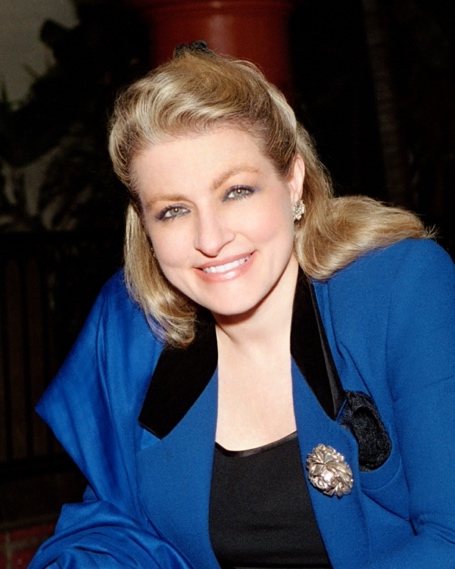
Gisèle Ben-Dor
Conductor Emerita, Pro Arte Chamber Orchestra of Boston
BORN IN: Uruguay
Carnegie Corporation of New York Honors 34 Great Immigrants for Their Contributions to Our Democracy
Annual tribute from the philanthropic foundation established by Andrew Carnegie focuses on naturalized citizens who live their lives in service to society
New York, New York, June 30, 2021 — Carnegie Corporation of New York released its annual list of Great Immigrants today, honoring 34 individuals who have enriched and strengthened our society and our democracy through their contributions and actions. The philanthropic foundation invites Americans to celebrate these distinguished individuals by participating in its online public awareness campaign Great Immigrants, Great Americans, #GreatImmigrants.
The Class of 2021 represents more than 30 countries of origin and emphasizes service to society, including honorees who are recognized for helping others as medical providers and researchers; as advocates for the disadvantaged, disabled, and disenfranchised; and as changemakers in politics, voting rights, climate change, and teaching. Overall the honorees have a wide variety of backgrounds and careers, including the chairman and CEO of Pfizer; the head of Google’s interactive design; the creator of language-learning software Duolingo; winners of the Pulitzer, Nobel, Vilcek and Beard prizes; and celebrities such as actress Helen Mirren and comedian John Oliver.
RELEASED 2021
“Cien Años”
“One Hundred Years”
A celebration of Piazzolla’s 100 Anniversary
Gisèle Ben-Dor, Juanjo Mosalini
Boston Pro-Arte Chamber Orchestra
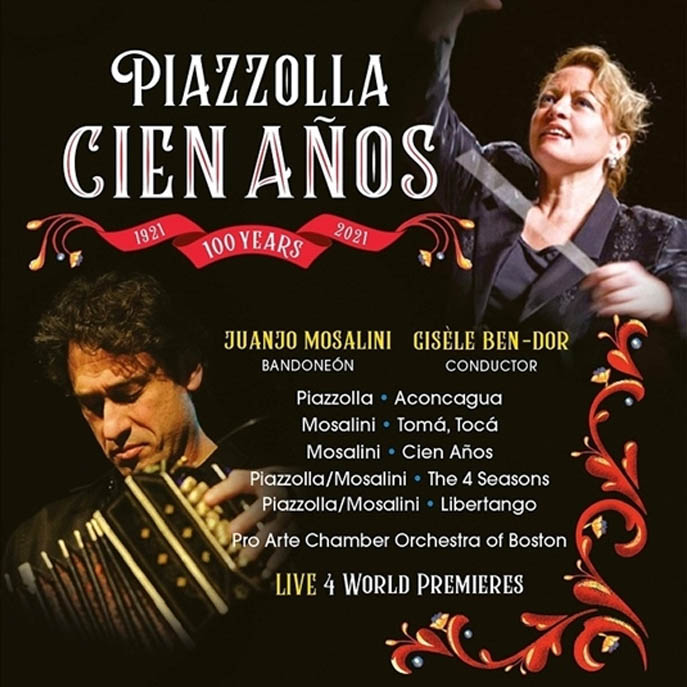
REVIEWS
Piazzolla: Cien Años. Mosalini. Ben-Dor, Pro Arte. Centaur.
Bandoneón virtuso Juanjo Mosalini, also an accomplished composer and arranger, is joined by Gisèle Ben-Dor for another release marking Astor Piazzolla’s 100th birthday year. The dualities of Piazzolla’s music are underscored—classical discipline vs. spontaneous impulse, Baroque angularity vs. the sensual melancholia of nuevo tango. The program opens with a performance of Pizzolla’s 1979 Concerto for Brandoneón that, thanks to Mosalini’s fluent virtuosity and conductor Ben-Dor’s propulsive support, is as effective as any I’ve heard. Four world premiere recordings follow the Concerto, including two original works by Mosalini. Take It, Play It is dedicated to Piazzolla’s electric guitarist, Tomás Gubitsch, and Cien Años, commissioned by Ben-Dor, honors Mosalini’s grandfather and also serves to mark the Piazzolla centenary. Mosalini’s music channels the style and mood of the earlier Argentinian composer without seeming imitative. The album’s highlights are two Mosalini arrangements. The Four Seasons of Buenos Aires is a 24-minute suite based on four stand-alone pieces conceived for Piazzolla’s quintet, and the disc closes with an exhilarating version of Libertango. The program has been vividly recorded by Brad Michael with the bandoneon forward in the mix, though not oversized.
the absolute sound, October 2021, Andrew Quint
GRAMOPHONE – Piazzolla: Cien Años
This programme may have been designed as a centenary tribute to Astor Piazzolla but it’s Juanjo Mosalini who steals the limelight. Mosalini’s vividly characterised account of the Bandoneón Concerto is viscerally exciting, and not merely because his playing in the outer movements is so propulsive and rhythmically taut – he drives the finale hard, seeming to leap through the semiquaver licks – but also because his generously long-breathed phrasing in the slow movement generates such a powerful emotional undertow.
Even more impressive, perhaps, is Mosalini’s arrangement of The Four Seasons of Buenos Aires. There have been other adaptations of these works for string orchestra, including a daringly free recomposition by Leonid Desyatnikov, popularised through Gidon Kremer’s Nonesuch recording (5/00), and Roberto Molinelli’s more respectful yet equally effective version, recently recorded by the Cappella Gabetta (Sony, 7/19). Mosalini’s falls somewhere between the two; he’s done extensive rewriting yet it’s in a style that’s in tune with the originals. Indeed, Mosalini highlights the music’s cinematic qualities, which seems fitting for Piazzolla, who wrote dozens of film scores over the course of his career. What’s unusual here (besides the fact that the primary solo part is for bandoneón rather than violin) is that Mosalini has sewn the four separate pieces together to form a single 25-minute movement. The stitching is deftly done (listen, say, at 17’06”, where he subtly joins ‘Winter’ and ‘Spring’), although the result cannot disguise the fact that – engaging as it is – this is a suite rather than a through-composed entity.
Mosalini also proves to be a fine composer in his own right. His debt to Piazzolla – and the Argentine folkloric style of Piazzolla’s teacher Ginastera – is readily discernible in the toccata-like Tomá, tocá (‘Take it, play it’), and while Cien años doesn’t really stake out new territory, there’s something distinctive in the score’s harmonic restlessness and lyrical ache. Both works are skilfully crafted, in any case, and the entire programme is performed with gusto. Boston’s cooperative chamber orchestra not only play with élan for Gisèle Ben-Dor, they’re with Mosalini every step of the way.
Author: Andrew Farach-Colton
Piazzolla Cien Años: Lord of the Tango@100
Raul Da Gama, NOV 5, 2021
…….nuevo tango continues to burn, now seemingly with an eternal flame, one hundred years on. ….. celebrated Uruguayan conductor Gisèle Ben-Dor, a fierce champion of South American music composers. Her brilliant work with the Pro Arte Chamber Orchestra of Boston features the prodigious composer and bandoneonist Juanjo Mosalini, and also features world premieres of works by both Piazzolla and Mosalini.
Piazzolla Cien Años – Juanjo Mosalini – Gisèle Ben-Dor – Boston Pro Arte Chamber Orchestra
Gisèle Ben-Dor is a conductor who clearly dines far further afield than many of her contemporaries, offering more than the meat-and-potatoes repertoire offered by a majority of her peers. Her interpretation of Mr Piazzolla’s great work “Aconcagua: Concerto for Bandoneón [1979]” gives new meaning to the phrase: “a sense of time and place”. Moreover, in these works, Ms Ben-Dor conveys the sense of Piazzolla being a distinctively Argentinean composer on the scale of Ginastera. In the concerto, for instance, she brings a special alertness to the pointing of phrase and building of form that makes sense of the composer’s unique way with tango.
…it is Ms Ben-Dor who must be principally credited for the deftness that she brings to the movements……, with a flexible but coherent movement takes her time to draw out the second “Moderato” movement, which steals in with sensuous reticence.
The manner in which each of Mr Piazzolla’s picturesque episode and naturalistic detail is called to mind, the synchronicity of motion and expressive intent within the concerto as well as in the other works is passionately conveyed.
This recording is one of the most memorable of all those that now serve to mark the centenary celebrations of the Argentinean maestro, not simply by the grand scale of it all, but by the sizzling performances, the magnificent retelling of the Piazzolla story, by painting vivid pictures with picture and painting coming dramatically alive as if in the day when the great one himself inhabited these pieces.
Raul Da Gama
Based in Milton, Ontario, Canada, Raul is a poet, musician and an accomplished critic whose profound analysis is reinforced by his deep understanding of music, technically as well as historically.
Planet Hugill – A world of classical music
Our final disc celebrates Piazzolla both with his own music and with a composer inspired by him. Uruguay-born American Israeli conductor Gisele Ben-Dor conducts Juanjo Mosalini (bandoneon) and the Pro Arte Chamber Orchestra of Boston on Centaur Records (CRC 3844) in Piazzolla’s Concerto for Bandoneon, Las Cuatro Estaciones Porteñas and Libertango, the latter two in Mosalini’s own arrangements, plus two of his own pieces. Mosalini is Argentine-born but brought up in Paris where is father, a distinguished Argentine musician, was in exile.
This performance takes us, I think, a bit closer to the original concept for the concerto. There is more of an edge, less of a luxurious cushion to the orchestra and the players relish the moments where Piazzolla turns them into a real tango-band. For his part, Mosalini plays the bandoneon to the manner born and makes the instrument sophisticated whilst preserving the vigour, roughness and edge that is needed. This is music which has been brought into the concert hall, but still with a whiff of the bar room.
Mosalini’s own Cien Años was composed, not for Piazzolla but for his own grandfather, yet it fits here and is paired with Mosalini’s Toma, Toca dedicated to Piazzolla’s former electric guitar player Tomas Gubitsch. Both engaging and examples of the continuation of Piazzolla’s tradition.
Las Cuatro Estaciones Porteñas features Mosalini’s new arrangement for bandoneon and orchestra, and it is clear quite how each version re-invents the piece as there are moments when you wonder whether this is the same music. As with the concerto, there is more edge here, rhythms are tighter and those sharp-edged tangos are rarely far away whilst you can feel that smoky bar-room. I really enjoyed this performance and will return to it, partly because you feel that for all their Western European-style sophistication, the musicians are willing and able to get down and dirty too.
And we end with a terrific version of Libertango in Mosalini’s own arrangement again for bandoneon and strings.
I am still waiting for that disc where a modern quintet gets down and dirty with Piazzolla’s music. Perhaps that is no longer possible, we simply listen to it with too sophisticated ears.
Review by Robert Hugill
A marvelous Piazzolla centenary tribute
Reviewed in the United States on August 12, 2021
Piazzolla: Cien Años (Centaur) commemorates the 100th birthday of the Argentine bandoneón virtuoso and composer Astor Piazzolla (1921-1992). Bandoneón soloist Juanjo Mosalini joins the Pro Arte Chamber Orchestra of Boston, under the direction of its Conductor Emerita, Gisèle Ben-Dor. The recording opens with Piazzolla’s bandoneón concerto, Aconcagua. Four world premiere recordings follow, all, like Aconcagua, scored here for bandoneón and orchestra. First is Mosalini’s vibrant Tomá, Tocá (Take It, Play It), dedicated to Tomás Gubitsch, an electric guitarist who performed with Piazzolla. Mosalini composed the reflective Cien Años (One Hundred Years) in memory of his grandfather. The timing of the work’s creation also coincides with the Piazzolla centenary. Mosalini’s arrangements of Piazzolla’s The Four Seasons of Buenos Aires (Cuatro Estacíones Porteñas) and Libertango conclude the disc. Cien Años and the arrangement of The Four Seasons were both commissioned by Ben-Dor. Mosalini is a superb instrumentalist, a technically brilliant artist whose playing is both unfailingly kinetic, and suave in tone and phrasing. It is seductive music making; and isn’t that perhaps the highest compliment one can pay to an interpreter of tangos? Mosalini layers improvisational elements into Piazzolla’s three-movement Aconcagua, certainly appropriate for the character of this music, and highly effective. Both Mosalini’s Tomá, Tocá and Cien Años are brief, single-movement works that feature a convincing and beguiling synthesis of various popular and classical elements, very much in the Piazzolla tradition. Piazzolla composed the movements of the work now known as The Four Seasons of Buenos Aires separately, and over a period of about 5 years. It is now known as a unified work (sometimes a concert companion to Vivaldi’s Le quattro stagioni) and has been arranged for various complements of instruments. In his arrangement for bandoneón and orchestra, Mosalini adds connective tissue so that that the four movements are performed without pause. It’s a lovely effect, and one that fits into the work’s 25-minute time span without strain. The disc concludes with a stirring rendition of one of Piazzolla’s signature works, Libertango. Conductor Gisèle Ben-Dor has long been a superb advocate for Latin-American music. Here, she leads the Pro Arte Chamber Orchestra in performances that are teeming with color, style, and irrepressible energy. The recording, which positions the listener in close proximity to the artists (but not oppressively so), packs considerable impact. Both Pablo Aslan and Ben-Dor contribute lively and informative commentary for the CD booklet, which also includes artist bios. A worthy and highly engaging centenary tribute to the father of the Tango Nuevo.
Recommended, Ken Meltzer
5.0 out of 5 stars
A superb centenary tribute to the great tango master
Reviewed in the United States on August 9, 2021
Just as the nocturne and the mazurka are synonymous with Chopin, the tango instantly brings to mind the name of Astor Piazzolla, whose centenary is being celebrated by this vibrant album titled simply Cien Años. Not many major composers adopted the tango (Stravinsky’s version in L’histoire du Soldat is so cool and detached it betrays the very nature of tango). It speaks volumes about the remoteness of South America from the minds of classical composers that the dumka and polonaise drew immense attention by comparison.
But once Piazzolla was discovered outside Argentina, no one has attracted more affection from a wide range of classical performers. The eroticism so dominant in tango dance programs doesn’t often seep through when Piazzolla makes it to Carnegie Hall, but he has so much to offer melodically, harmonically, and rhythmically that Eros is a side issue. No popular dance form besides the Viennese waltz has been as lucky in the sophistication that one genius brought to it. Piazzolla’s signature is indelible, and his music survives a wealth of arrangements and “derangements” (to borrow Thomas Beecham’s witty term) without losing its essence.
For all that, Piazzolla’s tangos have perhaps been passed from hand to hand too much for their own good, outside Argentina at least. Their foster homes in the U.S. and Europe haven’t always been congenial, which makes this new release stand out for sounding and feeling like the real thing. Piazzolla’s instrument was the bandoneon, and it occupies center stage on the program, played with undeniable charisma by Juanjo Mosalini, a recognized master of the instrument who was born in Buenos Aires in 1972 and whose career has an international reach.
In Western folk and popular music there are many varieties of bellows-driven reed instruments, each with its own character. The tango, to my ears, is inconceivable on Lawrence Welk’s accordion. Like the harmonica, the bandoneon is intimate and personal, but the harmonica in erotic mode is fairly laughable. The bandoneon has its own come-hither allure, and it can weave a melody as sinuously as the bodies of impassioned tango dancers. Piazzolla studied in Paris with Nadia Boulanger, and he created Nuevo tango as a malleable genre that fluidly crosses over between the concert hall and the dockside bars and clubs of Buenos Aires.
A beautiful aspect of Mosalini’s playing is his ability to inhabit every world Piazzolla’s music takes us to, from the swanky to the gritty. The most urbane work here is the Concerto for Bandoneón, often just called Aconcagua. The music is relatively refined, the earthiness and growl of the bandoneon tempered for civilized purposes. But tango is still palpable, as explained in the readable and helpful program notes: “Many of Piazzolla’s compositions begin with a riff, a jagged theme that repeats insistently. Most of them have an air of milonga, the ancestral music of Buenos Aires.” As related to the bandoneon concerto, “the underlying pulse undulates in groups of 3, 3, and 2 right from the opening statement.”
This off-balance rhythm gives tango its signature, and in the most famous work here, The Four Seasons of Buenos Aires, Piazzolla puts the basic rhythmic pulse through endless, fascinating changes, greatly aided by Mosalini’s arrangement for bandoneon and chamber orchestra—he adds punch to the accents and imbues the music with touches of his own personality. There are other arrangements by him on the disc, listed as world premieres, the most dazzling being an original composition, Tomá, Tocá, a bravura variant of a toccata in which he plays a Moto perpetuo in sixteenth notes while the tango melody is punched out as if by a third hand. Another of his pieces, Cien Años, the album’s title work, is tenderly reminiscent of smoky Parisian cafés at midnight, nodding to that strain of Piazzolla’s imagination.
As remarkable as Mosalini is, such an imaginative release owes just as much to , Gisèle Ben-Dor, the emeritus conductor of the Pro Arte Chamber Orchestra of Boston. Not only does she lead each piece with sympathy and a knowing hand, keeping the tango pulse alive and vibrant, but Ben-Dor commissioned Mosalini’s Cien Años and his arrangement of The Four Seasons. The latter alone is enough to make this release a significant addition to the burgeoning Piazzolla discography, given is originality and its inspired take on the original. All lovers of Piazzolla will be grateful to Ben-Dor for a project that has wound up being a superb listen.
Warmly recommended as one of the liveliest, most entertaining albums of the year.
Huntley Dent
The Boston Music Intelligencer
a virtual journal and essential blog of the classical music scene in greater Boston
Lee Eiseman, publisher; Robert Levin, advisor; David Moran, assisting editor; Bettina A. Norton, emerita editor
JANUARY 14, 2020
Pro Arte Tangos in the Cambridge Pampas
The art of Astor Piazzolla comes one’s way more frequently than not in a form of an encore, leaving the listener both enjoying the piece and wondering whether having heard one Piazzolla, one has heard them all. Gisele Ben-Dor led Pro Arte Chamber Orchestra, and tango nuevo specialist Juanjo Mosalini for a thorough exploration of the genre based on two of Mosalini’s own pieces, and a large number of examples by the Argentinian master. Mosalini’s virtuosic bandoneon dominated in all its glory and limitations at Sanders on Sunday.
Two premieres of his own pieces for bandoneon and strings began the concert. First, a good-natured and pleasant tribute to Mosalini’s friend and colleague Tomas Gubitsh, titled Tomá, Tocá took proper advantage of the bright reed accordion’s one-note-at- time expressiveness in long narrative lines. Then Cien Años celebrated the generations of bandoneon players in the composer’s direct lineage, as well as the instrument’s role in birth, and then rebirth of tango. After the promising beginning, many button bellows went silent, as concertmaster Kristina Nilsson’s long, expressive violin solo took complete possession of the stage. The main hero returned, joining the orchestra and recapturing the violin’s theme and spirit. If Mosolini had been making a point that this expandable black box can compete with the violin as the lyrical hero, the argument was rather persuasive.
Piazzolla’s Four Seasons of Buenos Aires had originated with Summer before growing to four separate pieces, first played by the composer’s tango quintet, which, of course, included bandoneon; lately it has really taken wing in a number of arrangements, most famously by Leonid Desyatnikov to a Gidon Kremer commission. Kremer programmed it along with Vivaldi’s Quattro Stagioni, and the arrangement not only quoted the familiar Inverno downpours, but also in general thrived on string textures and perfect articulation of themes. For this performance, Moselini attempted to restore the primacy of the bandoneon, and to this reviewer’s ears, Seasons suffered for that. The instrument’s role as a staccato accompaniment did not play up its best capabilities and became somewhat tiresome. It lost the urgency and some of the intensity of the string arrangements, and became less soulful, even though leaders of string sections of Pro Arte played their respective solos beautifully. I did not catch any Vivaldi’s Winter quotations in Piazzolla’s Summer either. But maybe there was little need: as I look at my weather app now, the temperature in Buenos Aires in the midst of their warm season is lower than it was in Harvard Square during this warm January 12th afternoon. Get a quote from a climate scientist about that.
Though Libertango often unfolds in slow and improvisational buildup that culminated in the catchy theme, yesterday we heard a much more streamlined and uniform take that felt somewhat short of the full range of this crowd pleaser’s expressive potential. Again the bandoneon came across as a bit domineering.
Then came Piazzolla’s magnum opus, the Aconcagua Concerto. Here the harmoniousness between bandoneon and the world gloriously returned. Timpani and percussion, along with a harp and a piano, took the burden off of the instrument that previously tried to carry all rhythmic and accompaniment duties. In the slow movement, slow brooding bandoneon lines over harp and piano accompaniment led to haunting sonorities you would not hear with any other combination. Gisele Ben-Dor achieved a strings texture that breathed like a single vocalist. This great interpretation of the concerto restored one’s appreciation of the balanced place of the tango nuevo patriarch in this essential repertoire.
As an encore, Pro Arte delivered a hot renditions of Por una cabeza by Carlos Gardel Oblivion by Piazzolla, assuring the gleeful crowd that tango viejo was not about to roll over either.
Boston Classical Review
Andrew J. Sammut
JANUARY 13, 2020
Pro Arte Orchestra explores the world of Piazzolla and the bandoneon
Bandoneonist Juanjo Mosalini was the soloist in the Pro Arte Chamber Orchestra’s program Sunday at the Sanders Theatre.
Astor Piazzolla explored modern harmonies and extended forms with his tango ensembles, bringing a new expressiveness to the music of his native Argentina. His tango-infused compositions in turn expanded the rhythmic and melodic vocabulary of the classical repertoire.
Pro Arte Chamber Orchestra of Boston and conductor Gisè le Ben-Dor celebrated Piazzolla’s distinct legacy in their own unique program on Sunday at Sanders Theatre. “Nuevo Tango” featured guest soloist Juanjo Mosalini in works by Piazzolla as well as premieres of the bandoneonist’s own compositions and transcriptions of Piazzolla’s music.
The bandoneon-relative of the much-maligned accordion-is rarely heard in orchestral settings. Yet it is synonymous with both Argentinian music and the late Piazzolla’s own performances.
Piazzolla’s Aconagua, Concerto for Bandoneon was the final work on the program but the most powerful performance of the afternoon. Piazzolla’s publisher titled the 1979 concerto after the highest mountain peak in the western hemisphere to signify it as the summit of the composer’s work.
Piazzolla studied with the likes of Nadia Boulanger and Alberto Ginastera, and Aconagua synthesizes that expert handling of harmony, counterpoint, and other compositional techniques with the diverse themes, moods, and rhythms of tango Piazzolla played and lived his whole life. The concerto is scored for chamber orchestra with percussion including piano and harp, and comprises two intense outer movements surrounding a wistful middle section.
Pro Arte burst into the opening Allegro marcato with bold declaratory phrases. The augmented instrumentation strengthened orchestral textures while clarifying the rhythmic profile. Ben-Dor patiently expanded the central Moderato from a morose reflection into a throbbing outburst. Orchestral entrances behind the soloist stayed gentle and flowing. The conductor also maintained a driving clip in the final Presto. A slow seductive ground rhythm emerged, with the string players striking the fingerboards and backs of their instruments, before a roaring march closed a concerto that earned applause after each movement.
Mosalini demonstrated the dexterity and passion of a concert virtuoso throughout. His tender a cappella asides in the first movement and undulating phrases in the second felt like warm serenades. In the Presto, Mosalini’s crisp phrase endings and drawling slides between notes made for a clever and convincing dramatic compromise between the movement’s anxious first section and lazy second theme.
Sunday also marked the world premiere of Mosalini’s arrangement of Piazzolla’s The Four Seasons of Buenos Aires. An homage to Vivaldi’s Four Seasons transplanted to the capital of Piazzolla’s homeland, these “seasons” were composed at different points between 1965 and 1970. He would perform them with his quintet but rarely together. Mosalini’s version not only makes the bandoneon a soloist, but it connects the four separate works into one lengthy and intense tour.
“Summer” started the work with an earthy feel. Mosalini leaned into sour crushes of notes on top of the string’s pop and thrust, with Ben-Dor’s slight push bringing out the melodic side of the accompaniment. Finely articulated phrases from both Mosalini and principal cellist Steven Laven marked the peaceful moments of “Autumn” and “Winter.” Yet scratchy glissandos, anxious tremolos and the string players knocking catchy beats on their instruments were a thread throughout Mosalini’s long suite. “Spring” packed soloist and ensemble alongside one another in close contrapuntal phrases. With the bandoneon’s wider timbre and louder volume, the effect was less differentiated. The angular minor key groove still came through.
Other parts of the program emphasized harmony and texture over rhythm. Tomá, Tocá, Mosalini’s tribute to a guitarist colleague, began with a swirling orchestra before rapid-fire bandoneon licks over a reiterated pizzicato dance rhythm. The overall feel was of a controlled exhibition tango rather than a visceral nightclub outing, heightened by a cool glaze of violins in the middle.
Creaking dissonant strings introduced Mosalini’s Cien Años, a commission by Ben-Dor for Pro Arte heard in its world premiere on Sunday. Based on a sad motif that seems to climb only to inevitably fall, Mosalini’s organ=like tones and syncopated pumps over Argentine milonga and tango accents unveiled a varied timbral palette. Unfortunately, Mosalini’s arrangement of Piazzolla’ Libertango could have used a stronger bass line to underpin the infectious theme, even with the incisive violins and rich, rhythmic bandoneon chords.
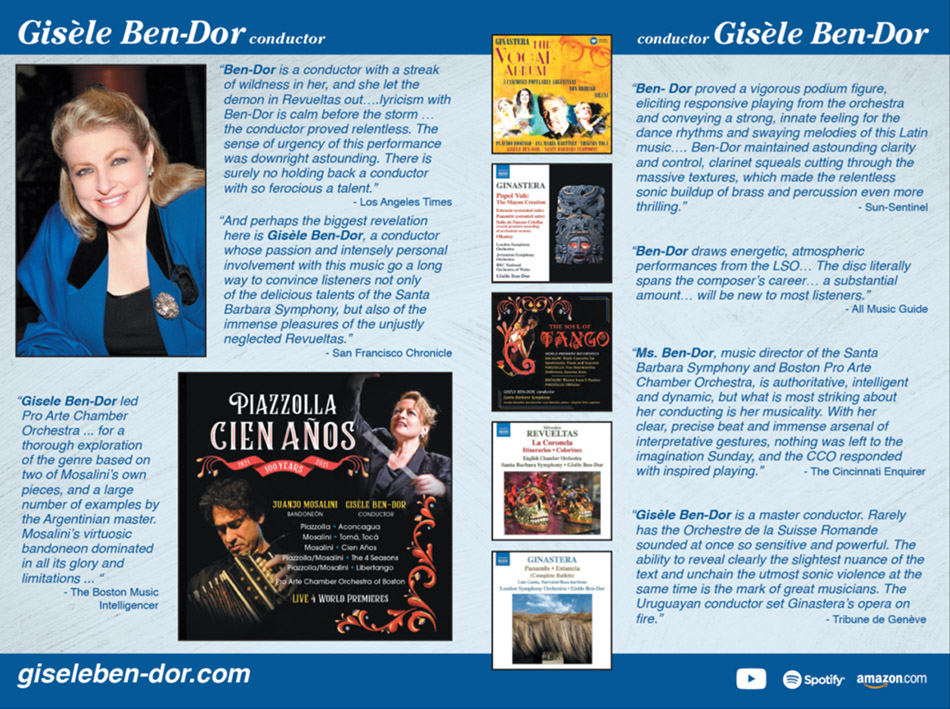
The disc is obviously a labor of love. Mosalini is the perfect soloist, and Gisèle Ben-Dor’s leadership is unsurpassed, especially in the articulation of the emotional shading. The orchestra, especially the string soloists, play as if they were in Buenos Aires. Sound quality is also very fine, especially for a concert recording. Tango devotees will find this programme a worthy tribute to Piazzolla. Those interested in exploring the tango might as well start at the top, with this disc.
-William Kreindler
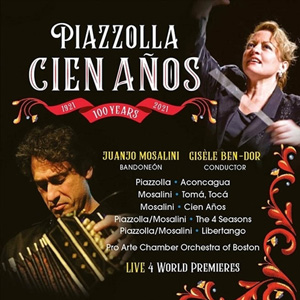 One might not think of Boston as a center of the tango, but the Pro Arte Chamber Orchestra under Gisèle Ben-Dor, its former conductor and now Conductor Emerita, have programmed the dance. Astor Piazzolla created Nuevo Tango – meant for listening, not dancing – and is the best-known advocate of Tango music. Works on this disc, which commemorates his centenary, were either written for bandoneón and orchestra or arranged by Juanjo Mosalini, perhaps today’s foremost soloist on the instrument. This accordion with buttons rather than keys is a fixture of Argentinian popular music.
One might not think of Boston as a center of the tango, but the Pro Arte Chamber Orchestra under Gisèle Ben-Dor, its former conductor and now Conductor Emerita, have programmed the dance. Astor Piazzolla created Nuevo Tango – meant for listening, not dancing – and is the best-known advocate of Tango music. Works on this disc, which commemorates his centenary, were either written for bandoneón and orchestra or arranged by Juanjo Mosalini, perhaps today’s foremost soloist on the instrument. This accordion with buttons rather than keys is a fixture of Argentinian popular music.
Between 1965 and 1970, Piazzolla wrote four pieces which describe Buenos Aires in different seasons of the year. Known together as Estaciones Porteñas, they are not a suite but Piazzolla’s quintet or octet would sometimes play them together. In 1996-1998, Russian composer Leonid Desyatnikov arranged them as a suite for violin and orchestra. Mosalini’s new arrangement for bandoneón and orchestra was made at Ben-Dor’s request. He also linked the movements and edited them into a sort of symphonic poem. Its elements range from a big-city motif, not unlike that in Vaughan Williams’s London Symphony, through the typical nostalgic Tango, to descriptions of the actual seasons. The work continues with depicting the busy streets of Buenos Aires before the final apotheosis of the city. I found this music evocative and truly affecting.
Mosalini wrote the tango Cien Años (100 years) in memory of his grandfather. This arrangement, also made at Ben-Dor’s request, is a centenary homage to Piazzolla. It starts with an introduction fiull of pathos, becomes more energetic, and ends in sadness – a fine tribute to both men. Tomá, Tocá (take it, play it) is very original, notably in its use of solo strings. Mosalini has also arranged Piazzolla’s well-known Libertango, written during one the master’s lengthy stays in Europe. Classical music and jazz both deeply influenced Piazzolla. This piece’s propulsiveness harks back to Baroque music.
Aconcagua is the highest mountain in the Americas. Piazzolla’s publisher bestowed the name on his 1979 Concerto for Bandoneón and Orchestra: he considered it the pinnacle of Piazzolla’s output. It is scored for strings, piano, harp, tympani and percussion. The vigorous first movement, almost a double concerto for bandoneón and piano, may bring Stravinsky to mind. The typical Tango nostalgia is ever-present, and is developed in classical fashion. All three movements are expertly scored. The second begins with a haunting cadenza for the soloist, joined by strings as the cadenza material is developed. The last movement echoes the first in excitement; hints of Stravinsky or perhaps Les Six are present again. After a heartfelt slower section, the movement becomes intense before ending abruptly.
The disc is obviously a labor of love. Mosalini is the perfect soloist, and Gisèle Ben-Dor’s leadership is unsurpassed, especially in the articulation of the emotional shading. The orchestra, especially the string soloists, play as if they were in Buenos Aires. Sound quality is also very fine, especially for a concert recording. Tango devotees will find this programme a worthy tribute to Piazzolla. Those interested in exploring the tango might as well start at the top, with this disc.
RECENTLY RELEASED
GINASTERA: THE VOCAL ALBUM
PLACIDO DOMINGO
ANA-MARIA MARTINEZ VIRGINIA
TOLASANTA BARBARA SYMPHONY
GISELE BEN-DOR
WARNER CLASICS
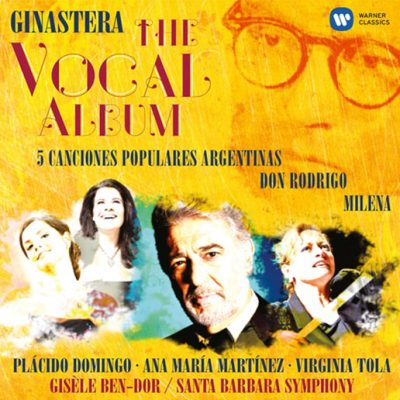
One composer, three worlds: Plácido Domingo in rare excerpts from Don Rodrigo; exciting folk rhythms and colors of Argentina; Kafka’s passionate soul.
Gisèle Ben-Dor is “… a conductor who spectacularly proves her credentials” CLASSIC CD
“… one of the best things that has ever happened to music of the southern hemisphere.” LOS ANGELES TIMES
REVIEWS
The Guardian, UK
Wednesday 9 March 2016
Placido Domingo revisits a past glory
Dramatic intensity … Placido Domingo sings extracts from Don Rodrigo, in which he first starred in 1966.
The discs that have already appeared to mark the centenary of the birth of Alberto Ginastera, which falls next month, mostly focus on the Argentinian’s flashier, better known orchestral scores. But this vocal collection is much more enterprising: alongside an orchestral arrangement of the early and unashamedly nationalist Five Popular Argentinian Songs there are two scenes from Ginastera’s almost forgotten first opera, Don Rodrigo, as well as the equally neglected cantata Milena, which sets extracts from Franz Kafka’s Letters to Milena.
The opera was completed in 1964 and the cantata seven years later. They both belong to what Ginastera called his “neo-expressionist” period, in which he adopted a 12-note technique (though without ever really losing touch with tonality) and included aleatoric passages in his scores. The results are close to the world of Berg at times, and the highly wrought, anguished vocal writing of the opera – built around the character of Roderic, the last Visigoth king of Spain, who probably died at the hands of the invading Moors in the 8th century – certainly recalls parts of Wozzeck. Milena is, if anything, even more intriguing. From a collage of excerpts in Spanish translation from Kafka’s text, Ginastera created a patchwork of dreams and longings that he shaped into five movements and scored with amazing imagination, using his experience of electronic music to create a shimmering, enchanted orchestral sound world. It’s a strikingly beautiful piece – a real discovery – which fades away with echoes of the last song in Schubert’s Winterreise.
The performances have real authority. When Don Rodrigo received its US premiere at New York City Opera in 1966, the title role was sung by a young tenor then at the beginning of his international career. It’s a role that Placido Domingo was always keen to repeat, and though we only get him singing two sections of the opera here – the climactic rape scene from the second act, and the final scene of the third, when the despairing Rodrigo dies and all the bells of Spain spontaneously ring out – they are enough to show the dramatic intensity he must have brought to it 50 years ago. The demanding part of Florinda, Rodrigo’s lover, is taken by Virginia Tola, though she is even more impressive threading her silvery soprano through the textures of Milena.
Assembling this disc has clearly been a labour of love for conductor Gisele Ben-Dor. It has taken her 15 years with the Santa Barbara Symphony, and to judge from the recording details, it’s been a tortuous process. Ana María Martínez’s performance of the Popular Songs dates back to 2002, while Tola recorded Milena and her part in the Don Rodrigo excerpts in 2008, before Domingo added his contributions in 2011 and 2014.
You hardly notice the joins, though, and in any case much of the music is such a treat that it doesn’t matter at all.
DIAPASON, France
May 2016
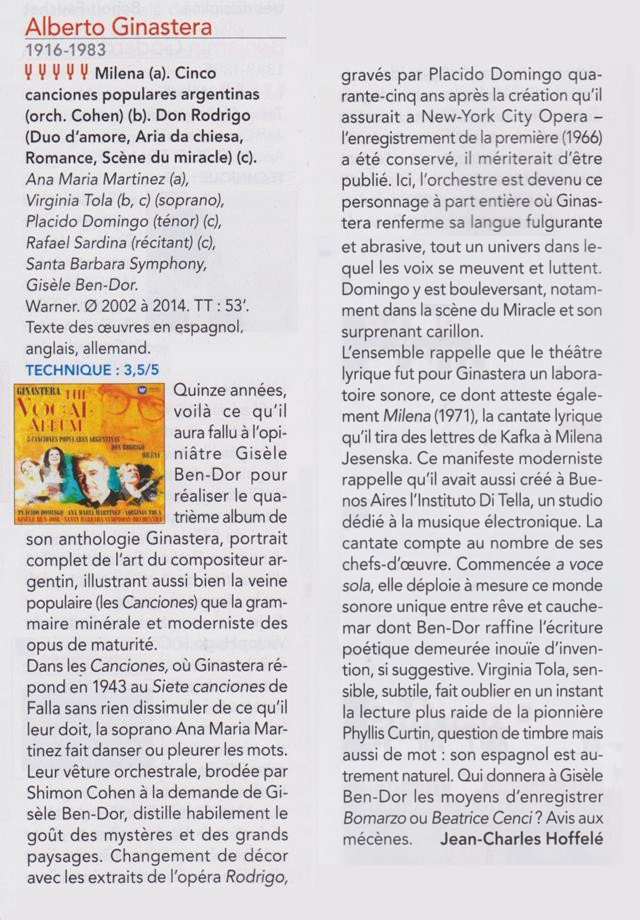
![]()
May 2016
Andrew Farach-Colton
GINASTERA The Vocal Album
Plácido Domingo sang the title-role in the US premiere of Alberto Ginastera’s Don Rodrigo with the New York City Opera in February 1966, inaugurating the company’s new home at Lincoln Center. Domingo’s career skyrocketed from there – although, sadly, neither Ginastera’s opera nor the City Opera itself fared quite so well. Thus there is no complete recording of Don Rodrigo, the first of Ginastera’s three operas (only Bomarzo was recorded in full and even that never made it to CD), so we must be especially grateful to Domingo for paying homage to his youthful triumph with these excerpts.
Pirated recordings of those 1966 City Opera performances are readily available, however, and comparing them with this new account, it’s astonishing how fresh Domingo still sounds 50 years later. It’s all the more impressive, considering that Ginastera’s score is comparable to Berg’s Lulu both stylistically and in its extreme technical demands. In fact, Domingo sounds far more expressive and fearless here, navigating the precipitous vocal lines with ease.
Reviewing the City Opera’s landmark production, New York Times critic Harold C Schonberg praised Ginastera’s ‘compositional surety’ but lamented the ‘lack of anything touching the heart’. Yet, in this account, the passion is palpable and often profoundly moving. Domingo conveys Rodrigo’s compulsive, destructive ardour with conviction and, more importantly, compassion. Virginia Tola is somewhat aloof as Florinda, the object of Rodrigo’s obsession, but shows more of her emotional mettle in Milena, Ginastera’s harrowing monodrama based on Kafka’s love letters. Phyllis Curtin, who recorded this cantata in the ’70s (Phoenix), offers greater richness and variety of tone; but Ginastera set the text in Spanish and, ultimately, Tola’s fluency packs a stronger punch.
The programme opens with a setting of popular Argentine songs in colourfully effective yet respectful orchestral arrangements, and Ana María Martínez sings them with gusto and an appropriate feeling of bittersweet nostalgia. Gisèle Ben-Dor draws secure and characterful playing from the Santa Barbara Symphony throughout.
The London Times

Classical
Plácido Domingo:
Ginastera — the Vocal Album
Warner Classics
Neil Fisher
June 3 2016, The Times
★★★★☆
It has taken a very long time, but at least Plácido Domingo’s celebration of Ginastera has made it out for the 100th anniversary year of Argentina’s national composer. The Uruguayan-born conductor Gisèle Ben-Dor started planning The Vocal Album in 1999. Recording began in 2002, when Ana María Martínez laid down her very fiery take on the early Cinco Canciones Populares Argentinas, in a newly orchestrated (and slightly over-egged) version by Shimon Cohen.
Various wrangles then meant that Domingo had to record his contributions to two chunky extracts from the 1964 opera Don Rodrigo without his duetting soprano, Virginia Tola, who also sings the 1971 cantata Milena. His parts were finished only in 2014, then another hiatus delayed the album’s release further.
These complications don’t dent the expressive power of those late works, however. If the Canciones belong to Ginastera’s “nationalist” period, Don Rodrigo and Milena come from the part of the composer’s life when he drifted to European modernism. Don Rodrigo has the heated plot of a verismo firecracker by Montemezzi or Wolf-Ferrari — the eponymous king rapes a woman he has sworn to protect, loses Spain, but is redeemed by a divine bell-ringing miracle. Yet its music sounds more like Alban Berg’s, the violence delivered in grinding dissonances and jagged vocal writing.
Domingo championed the same role at New York City Opera 50 years ago, and it’s remarkable enough that he came back to it. Some vocal tiredness doesn’t dilute his expressive force, and he skilfully judges the contrast between the two scenes, the first showing the king crazed by perverse passion, the second aged and spent. He is well partnered by the Argentinian Tola, and Ben-Dor conducts the Santa Barbara Symphony orchestra with plenty of heat.
Milena is the most compelling work on the album, however. Here Tola superbly sings and declaims extracts from the letters that Franz Kafka sent to the journalist Milena Jesenská (her replies are lost, alas). They are not love letters by any traditional measure — the famously un-optimistic author writes at one point that “we are both married, you to your husband in Vienna, I to anguish in Prague” — and Ginastera responds appropriately.
In alternating sections marked “Prose” and “Cantus”, he uses sepulchral colours and the eerie glint of electronic effects to create a chilling backdrop for the soloist to deliver Kafka’s paranoid angst. In the last section Ginastera quotes from the final song of Schubert’s Winterreise and then the music disappears into greyness.
Wiener Zeitung
19 May 2016
Hypnotizing Mastery
An anniversary album in honor of the legendary Argentine composer Alberto Ginastera’s (1916-1983) 100th birthday: Plácido Domingo, celebrating his own 75th birthday this year, is first in line to salute the composer who started his career. After all, it was the US premiere of Ginastera’s opera “Don Rodrigo” at the New York City Opera in 1966 that brought the Spanish tenor his first triumph. Naturally, excerpts from “Don Rodrigo” found their way onto this album (the lovers’ duet “Fortuna …” and the final church scene). Especially the epoch-making “Cinco Canciones Populares Argentinas” and the cantata “Milena” op. 37 (based on Kafka), as performed by Domingo, his Operalia discoveries Ana María Martínez and Virginia Tola and the Santa Barbara Symphony (expertly conducted by Gisèle Ben-Dor), highlight the South American flavor and originality inherent in the work of the Argentine master of sound. The perfect phrases (recorded over a period of 15 years; the excerpts from “Don Rodrigo” being first recordings) practically hypnotize the listener with their intensity.
Radio Klassik Stephansdom
CD of the week
Alberto Ginastera was born 100 years ago in Buenos Aires, on April 11, 1916. The conductor Gisèle Ben-Dor spent 15 years on the realization of the “The Vocal Album” project. She asked composer Shimon Cohen to orchestrate Ginastera’s “Canciones Populares Argentinas” and also brought Plácido Domingo on board, who famously started his world career in 1966 with his unforgettable title role performance in Ginastera’s opera “Don Rodrigo” in New York. Ursula Magnes treated herself to the wide spectrum of Ginastera’s music.
The compilation of the CD is wisely chosen. The listener is immediately taken by Ginastera’s popular folkloric and Argentine songs. Particularly since this is the first time they have been performed by an orchestra. Puerto Rican singer Ana Maria Martínez shapes these energetic true-to-life songs in a fluent and natural fashion.
As Plácido Domingo impressively demonstrates, Ginastera was also capable of creating a very different mood reminiscent of Alban Berg’s “Wozzeck”. Five years ago he went to a Los Angeles studio to resurrect and build on his 1966 breakthrough. This was his heart’s desire. The orchestral accompaniment by the Santa Barbara Symphony is intense and gripping.
With the cantata “Milena”, the text arranged by Ginastera himself from letters of Franz Kafka to Milena Jesenská, we get yet to experience a completely different side of Ginastera. To achieve this high degree of expressiveness, Ginastera crawls into Kafka’s angst-ridden world, acknowledging that “one can imagine this music accompanying a woman in her loneliness during the last faint twilight of her own life – and of the old social order – as she reads the letters from her deceased lover again and again.” A woman, the Argentinean soprano Virginia Tola, takes on Kafka’s interior monologue. It is no coincidence that Ginastera invokes the “Leiermann” from Franz Schubert’s “Winterreise”.
The composer died in 1983 in Geneva. This CD allowed me to discover his music with moments of pleasure, passion, and offered many eye-opening experiences.
From the Spanish press
Another composer whose centenary occurs in 2016 is Alberto Ginastera, probably the most important musical voice of Argentina in the Twentieth century.
The Warner label pays him homage with an album titled “The Vocal Album” , entrusted ,with very good judgment, to one of those American orchestras who are professional through and through but little favored by the promotional glamour: California’s Santa Barbara Symphony, under the baton of its conductor laureate Gisele Ben-Dor, of Uruguayan origins.
But if the album is titled “The Vocal Album”, it is because the protagonist is the voice: that of the Puerto Rican soprano Ana Maria Martinez in the Five Argentine Popular Songs Op 10 and the cantata Milena Op 37, and, above all, that of the great Placido Domingo, who returns to his tenor tessitura to leave a lasting testimony of recognition to Ginastera, recording, next to Argentine Virginia Tola, two scenes as a duo of what was his opera debut in New York :” Don Rodrigo, ” Op. 31. Domingo participated in the world premiere of the opera as a very young man, and now, at the end of his career, remembers that moment.
OTHER PRESS
Warner Classics, Press Release
“Ginastera – The Vocal Album” marks the centenary of Argentine composer Alberto Ginastera (1916-1983). In 1966, at the New York City Opera, the US premiere of his opera Don Rodrigo gave the young Placido Domingo his major breakthrough. Domingo performs excerpts from Don Rodrigo, while two sopranos – Ana Maria Martinez and Virginia Tola, respectively – sing Ginastera’s Cinco Canciones Populares Argentinas (Five Argentine Popular Songs), op. 10, in a World Premiere orchestral version, as well as cantata Milena, based on Franz Kafka’s Letters to Milena. Gisele Ben-Dor, a notable champion of Latin American music, conducts the Santa Barbara Symphony.
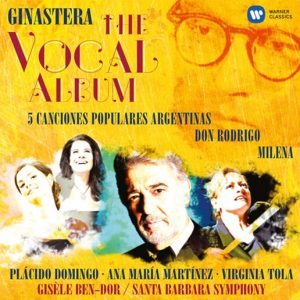
It was not in an opera by Verdi or Puccini that Plácido Domingo made his major and decisive breakthrough in New York, in 1966 at the age of 25. It was in fact in a work by the Argentinian composer Alberto Ginastera (1916-1983), whose centenary is celebrated with this album of operatic excerpts and concert music for voice.
The performers on Ginastera – The Vocal Album are Domingo, the sopranos Ana-Maria Martínez and Virginia Tola (both past prizewinners in Domingo’s Operalia competition) and California’s Santa Barbara Symphony under its conductor laureate, Gisèle Ben-Dor. She is a native of Uruguay, one of Argentina’s closest neighbours, and a notable champion of Latin American music. In 2004 – in collaboration with Ginastera’s daughter Georgina – she staged the Tango and Malambo Festival in Santa Barbara.
In his autobiographical book My First Forty Years, Domingo – whose 75th birthday falls in January 2016 – recounts his experience with Ginastera’s first opera. “In New York I embarked on the double adventure of singing the title role in the North American premiere of Ginastera’s Don Rodrigo and, with it, the opening of the City Opera’s new home at the New York State Theater in Lincoln Center … The opening night – 22nd February 1966 – was a special occasion and therefore received considerable attention … For the public it was an exciting evening: they had not seen a contemporary opera of that stature in a long time. For a young Spaniard to be able to sing, on such an occasion, the role of a Spanish king, and in Spanish, was an unforgettable experience. There was much praise for the work, for the production and, fortunately, for my singing. I did not realize at that moment what it all meant for my future.”
Don Rodrigo is set in Spain in the 8th century. The title character, also known historically as Roderic, is the last of the country’s Visigoth kings, and the opera – which, musically and structurally speaking, takes Alban Berg’s masterpiece Wozzeck as its model – recounts a gripping tale of pride, passion and downfall. As the New York Times wrote after its world premiere in Buenos Aires in 1964: “The music is powerful, direct, compelling — at times almost overwhelming in its dynamic intensity.”
If Don Rodrigo can be classified musically as a piece of atonal expressionism, the Cinco Canciones Populares Argentinas, dating from some 20 years earlier and written as a response to political turmoil in Argentina, draw directly on the country’s folk music and are full of Latin colours and inflections. Ana-Maria Martínez, born in Puerto Rico, lends her rich and mellow vocal texture to their evocative lines.
The Old World is the focus of the dramatic cantata Milena, composed in 1971 and performed with characteristic intensity by Virginia Tola, who is from Argentina. The cantata’s text is a Spanish translation of letters that Frank Kafka wrote (in German) to Milena Jesenská, who was the first person to translate his work into Czech. Kafka and Jesenská – who was married – met only twice, but, in the course of 1919 and 1920, they conducted an intense relationship via correspondence. The cantata, which makes use of both sung and spoken text, is composed in an uncompromisingly modern style, but includes a haunting musical quotation from Der Leiermann, the concluding song of Schubert’s gloomy song cycle Winterreise.
Simposio International de Mujeres Directoras, Invitada de Honor
(International Symposium of Women Conductor, Guest of Honor)
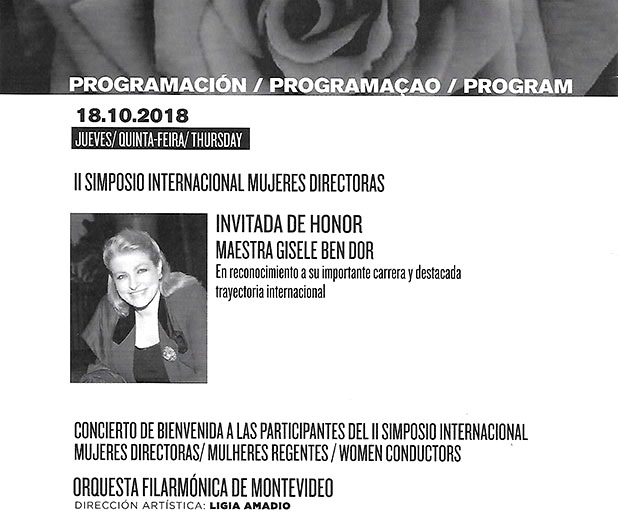
Gisèle Ben-Dor featured in Fanfare Magazine
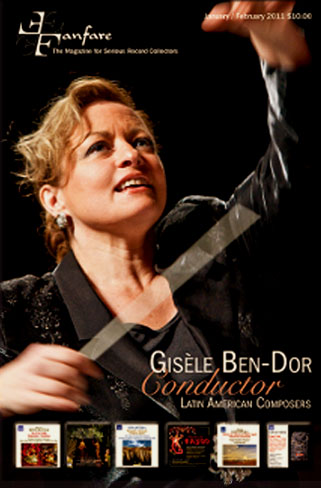
Gisèle Ben-Dor – Conductor, Latin American Composers
The Must-Have CDs

Gisele Ben-Dor’s CD of music by Alberto Ginastera (Glosses on Themes of Pablo Casals, orchestra and chamber versions, and Variaciones Concertantes, with the London Symphony Orchestra and the Israel Chamber Orchestra) is listed in this year’s
The Penguin Guide to the 1000 Finest Classical Recordings: The Must-Have CDs and DVDs
by Ivan March, Edward Greenfield, Robert Layton and Paul Czajkowski
“if you want to explore the full range of the composer’s melodic invention and vivid orchestral palette, you could hardly better this superbly played and recorded coupling…First rate recording too.” – Penguin Guide
GINASTERA Glosses on Themes of Pablo Casals: op. 46 for string quintet and string orchestra1; op. 48 for orchestra1. Variaciones concertantes2 • Gisèle Ben-Dor, cond; 1London SO: 2 Israel CO •
NAXOS 8.572249 (58:46)
Naxos is doing well by Ginastera. The label has recorded much of his chamber music, including the complete string quartets, and reissued two significant recordings of his orchestral music. This is the second of those reissues, recorded in 1995 and originally available on the Koch label.
The main point of interest in this program is the inclusion of both version of the late masterwork Glosses on Themes of Pablo Casals. The version for strings came first, written to celebrate the centenary of the beloved Catalan cellist in I975. (Ginastera’s cellist wife, Aurora, had been one of Casals’ disciples.) Two years later Rostropovich, then at the helm of the National Symphony Orchestra of Washington, D.C.. asked the composer for a new work and the result was the second version, fully scored and considerably re-thought in orchestral terms, so much so that it warranted a different opus number.
The work is more of an imaginative deconstruction and decoration of themes than a straightforward set of variations, hence the title “glosses”. Several pieces by Casals are quoted: in the first movement, a solemn chorale from his Prayer to the Virgin of Montserrat, an ardent love song in the second movement, and in the penultimate fourth movement the cellist’s well-known encore piece, Song of the Birds. In this work, Ginastera’s musical interests come together: His distant Catalan roots and (in the concluding sardana) Argentinean dance rhythms along with the technical intricacies of his late orchestral style, bracingly avant-garde at the time.
While the orchestral version is a true showpiece with many fascinating and effective moments—I love the (Gabrieli-style brass. scoring of the choral theme in the first movement—the string version has greater strength and unity. The work’s free-form structure feels less piecemeal when held together by string timbres. I know of a couple of fine recordings of full orchestral version postdating this one, but none of the string version. It is an asset to be able to compare both on one disc, and a salutary reminder of the composer’s fastidious ear for texture. The London Symphony play beautifully for Gisèle Ben-Dor, a specialist in Latin American music.
In between the two Glosses comes a set of genuine variations. The Variaciones Concertantes for chamber orchestra of 1953. The original theme is built on a chord of rising fourths, equating to the open strings of a guitar. A string ensemble provides the backdrop to a series of variations featuring one or two wind soloists per variation. All the forces come together in the final movement, which employs a favorite stamping dance rhythm of the composer, the Malambo. A popular and oft-recorded work, it receives a fine performance from the Israel Chamber Orchestra.
This has always been one of the most satisfying discs in the Ginastera catalog. If you missed it the first time around, you now have a bargain opportunity to remedy that error. Phillip Scott
266 Fanfare July/August 2010
Top 100 Music Downloads – Top iTunes Album Downloads
“…vintage Ginastera… vital, committed and convincing readings… All three orchestras respond superbly with playing of the highest quality. The recorded sound is excellent throughout”.
www.musicweb-international.com
“Ben-Dor draws energetic, atmospheric performances from the LSO… The disc literally spans the composer’s career… a substantial amount… will be new to most listeners.”
All Music Guide
Ginastera: Popol Vuh – The Mayan Creation
Gisele Ben-Dor, conductor
London Symphony Orchestra
Jerusalem Symphony Orchestra
BBC National Orchestra of Wales
